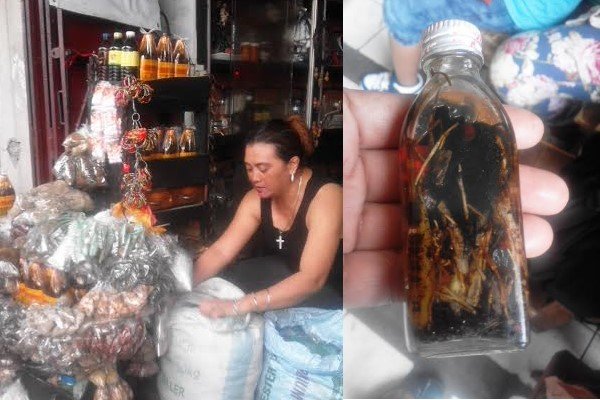Susan is in. A baby has its back to her, its face serene and innocent. It won’t be long when the baby screams in pain as had the baby before it, and all the other babies before have had. For generations, the manoghilot has been the go-to medicine man, or woman, for babies, toddlers and very young children who have a fever, or a persistent cough. “May kibit” is the usual reason for cases like this which is akin to a pinched nerve causing pain and blocking healing.
I had my episodes of primal screams, too, in childhood. For a cough that never goes away, I would be sent off to Tia Pacing of Trece y Media in Bago City. The good girl I was, I would sit still in the car throughout the journey from Bacolod. But, I dreaded each visit because this meant pain so excruciating that tears would roll down my cheeks. Tia Pacing, God bless her soul and magic fingers, relieved me of my cough every time.

I am at Susan’s for deep kneading on my back to take away the cold air, or panuhot. After I am almost done, an elderly woman passes by and asks, “Naga pangluy-a luy-a ka?” She shows a swelling in the crook of her right elbow that she said she got after she cleared part of her garden. Susan asks if that part hurts. “Yes.” “Ah, may sabid na.” Luy-a luy-a is the application of ginger on someone who is suspected of being a victim of an elemental’s anger. The woman takes my place while Susan cuts a thumb-sized piece of ginger. She peels it, and touches the ginger on the patient’s forehead, chest, the swelling, and back to the forehead where it stays for some time while Susan mutters an incantation. Afterwards, she holds the ginger on the top of the patient’s head.
Our medicine woman prescribes “tu-ob sang kamangyan” or smoking with hardened tree sap, but not with “insenso kay mangakig pa guid ina sila.” Insenso is also crystallized sap but is of lower quality as it is harvested from the lower parts of the tree trunk near the ground. Susan, then, tells her patient to go back to her garden and apologize to the spirits. Other appeasing steps are to offer an egg, and walk around the tree nine times. She admonishes, “Indi ka manghilabot kay ila ‘na ilistaran. Indi moni sila mapahalin kay ila ‘na balay.” (Do not disturb them because that is their abode. You cannot drive them away because that is their home.) And the final instruction to “kun sige hubag, hampulan mo sang kalawag.” (When swelling continues, apply a turmeric poultice.)

The patient leaves and a mother brings her baby up for a check-up. Her husband stands just beside Susan awaiting his turn. He might have a “balda”. Then, he squats close to Susan and talks to her in a tone so low that I cannot hear what he is saying even though I am just three feet away. Susan replies loudly, “Damo di ga pa-lumay ah.” Now, the secret is out! Then, she says, “Tatlo ka bulan ang lumay.” The man speaks again softly. And she answers, “Ay, abi mo hapos mag-lumay?”
When the last patient leaves, I sit near Susan and ask her to explain Lumay 101. Here’s what I discovered. Most buyers of Susan’s love potion are women with erring husbands – husbands who do not return home. She makes these potions from “siyam ka kahoy-kahoy nga guinapangalap sa bukid o sa kweba”. (She forages for nine kinds of herbs or tree bark from mountains or caves.) Potions are made-to-order and are made only on Tuesdays and Fridays. (Can you imagine her hunched over a cauldron?) Use three drops dripping from your fingertips and line the rim of the glass from where your target will drink from. And only on Tuesdays and Fridays. Treatment may last from three months to as long as seven years. Yet, before she gives the potion, she explains the repercussion of giving lumay to the “victim”. The perpetrator must be consistent and never skip administering the lumay. AND, never get caught by the victim. This causes the potion to not only be ineffective, but will make the target hate the giver. Maria admonishes her clients, “Kun gusto mo magbalik ang imo bana, lainon mo ang batasan mo. Kontrolon ang baba kay isa man na ka rason nga guinabayaan sang bana ang iya asawa.” The latter is pragmatic advice. Even the Book of Proverbs says “Better to live on a corner of the roof than share a house with a quarrelsome wife.” (Prov. 21:9)
Susan tells me another trick to get someone to fall in love with you. It involves washing certain body parts and doing something else afterwards. I will not divulge the process for one can do this by oneself, hence, can be done without any help. This, too, is witchcraft and is not pleasing to the Lord. The purpose of this article is to make people aware that our Filipino culture is alive and cooking, este, kicking even in the 21st century. Our folk medicines and cures are still available to those who do not have access to, or refuse to seek, Western medical aid. I believe in the hilot, but I draw the line there. For ailments that afflict body and emotion, there is no greater cure than that from the Great Physician. So, if love hurts, see our Healer.

